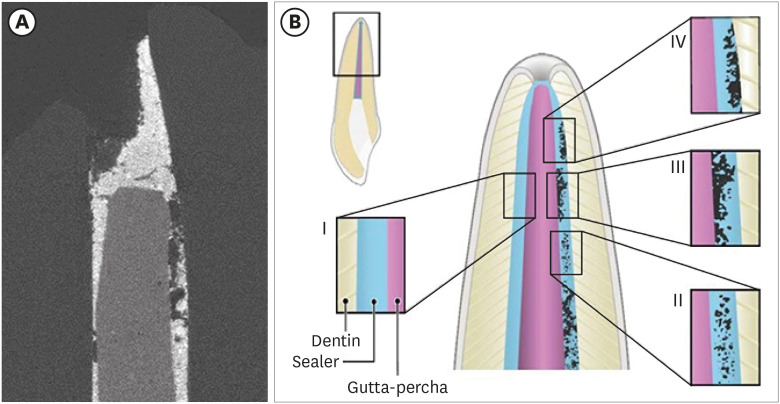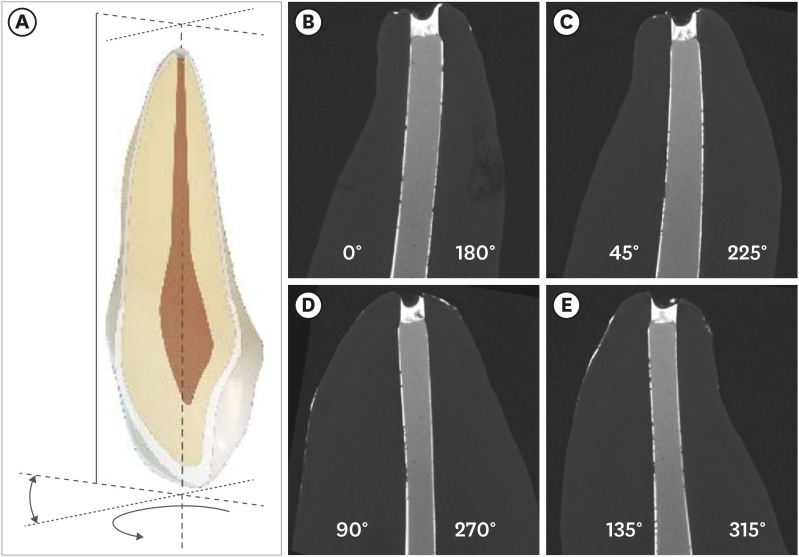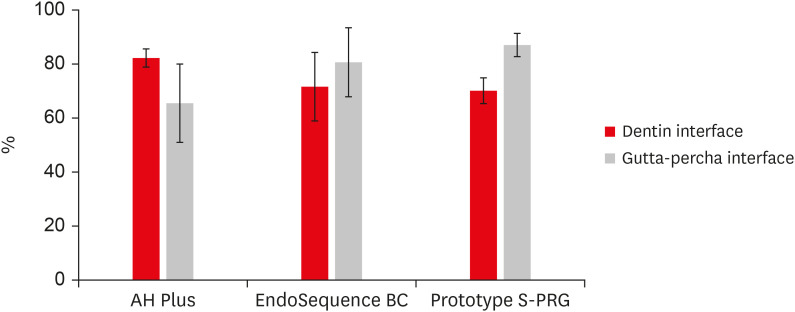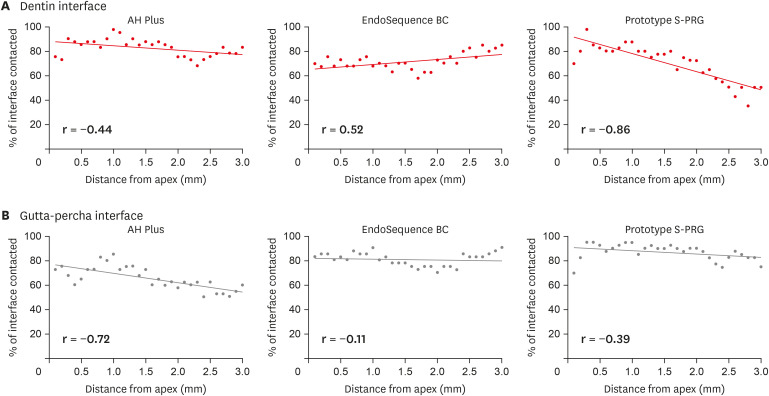1. Sjogren U, Hagglund B, Sundqvist G, Wing K. Factors affecting the long-term results of endodontic treatment. J Endod. 1990; 16:498–504. PMID:
2084204.

2. Ng YL, Mann V, Rahbaran S, Lewsey J, Gulabivala K. Outcome of primary root canal treatment: systematic review of the literature -- Part 2. Influence of clinical factors. Int Endod J. 2008; 41:6–31. PMID:
17931388.

3. Komabayashi T, Colmenar D, Cvach N, Bhat A, Primus C, Imai Y. Comprehensive review of current endodontic sealers. Dent Mater J. 2020; 39:703–720. PMID:
32213767.

4. Lacey S, Pitt Ford TR, Watson TF, Sherriff M. A study of the rheological properties of endodontic sealers. Int Endod J. 2005; 38:499–504. PMID:
16011766.

5. Schäfer E, Schrenker C, Zupanc J, Bürklein S. Percentage of gutta-percha filled areas in canals obturated with cross-linked gutta-percha core-carrier systems, single-cone and lateral compaction technique. J Endod. 2016; 42:294–298. PMID:
26679718.

6. Ray HA, Trope M. Periapical status of endodontically treated teeth in relation to the technical quality of the root filling and the coronal restoration. Int Endod J. 1995; 28:12–18. PMID:
7642323.

7. Kataoka H, Yoshioka T, Suda H, Imai Y. Dentin bonding and sealing ability of a new root canal resin sealer. J Endod. 2000; 26:230–235. PMID:
11199725.

8. Zhou HM, Shen Y, Zheng W, Li L, Zheng YF, Haapasalo M. Physical properties of 5 root canal sealers. J Endod. 2013; 39:1281–1286. PMID:
24041392.

9. Chybowski EA, Glickman GN, Patel Y, Fleury A, Solomon E, He J. Clinical outcome of non-surgical root canal treatment using a single-cone technique with endosequence bioceramic sealer: a retrospective analysis. J Endod. 2018; 44:941–945. PMID:
29606401.

10. Miki S, Kitagawa H, Kitagawa R, Kiba W, Hayashi M, Imazato S. Antibacterial activity of resin composites containing surface pre-reacted glass-ionomer (S-PRG) filler. Dent Mater. 2016; 32:1095–1102. PMID:
27417376.

11. Yassen GH, Huang R, Al-Zain A, Yoshida T, Gregory RL, Platt JA. Evaluation of selected properties of a new root repair cement containing surface pre-reacted glass ionomer fillers. Clin Oral Investig. 2016; 20:2139–2148.

12. Miyaji H, Mayumi K, Miyata S, Nishida E, Shitomi K, Hamamoto A, Tanaka S, Akasaka T. Comparative biological assessments of endodontic root canal sealer containing surface pre-reacted glass-ionomer (S-PRG) filler or silica filler. Dent Mater J. 2020; 39:287–294. PMID:
31776316.

13. Kusaka Y. Influence of root canal sealer containing S-PRG filler on osteogenesis in tibia of rats. J Meikai Dent Med. 2018; 47:139–147.
14. Keleş A, Alcin H, Kamalak A, Versiani MA. Micro-CT evaluation of root filling quality in oval-shaped canals. Int Endod J. 2014; 47:1177–1184. PMID:
24527697.
15. Celikten B, Uzuntas CF, Orhan AI, Orhan K, Tufenkci P, Kursun S, Demiralp KÖ. Evaluation of root canal sealer filling quality using a single-cone technique in oval shaped canals: an
in vitro micro-CT study. Scanning. 2016; 38:133–140. PMID:
26228657.

16. Jain S, Adhikari HD. Scanning electron microscopic evaluation of marginal adaptation of AH-plus, GuttaFlow, and RealSeal at apical one-third of root canals - part I: dentin-sealer interface. J Conserv Dent. 2018; 21:85–89. PMID:
29628654.
17. Adhikari HD, Jain S. Scanning electron microscopic evaluation of marginal adaptation of AH-Plus, GuttaFlow, and RealSeal at apical one-third of root canals - part II: core-sealer interface. J Conserv Dent. 2018; 21:90–94. PMID:
29628655.
18. Mohammadian F, Farahanimastary F, Dibaji F, Kharazifard MJ. Scanning electron microscopic evaluation of the sealer-dentine interface of three sealers. Iran Endod J. 2017; 12:38–42. PMID:
28179922.
19. Eltair M, Pitchika V, Hickel R, Kühnisch J, Diegritz C. Evaluation of the interface between gutta-percha and two types of sealers using scanning electron microscopy (SEM). Clin Oral Investig. 2018; 22:1631–1639.

20. Polineni S, Bolla N, Mandava P, Vemuri S, Mallela M, Gandham VM. Marginal adaptation of newer root canal sealers to dentin: a SEM study. J Conserv Dent. 2016; 19:360–363. PMID:
27563187.

21. Ray H, Seltzer S. A new glass ionomer root canal sealer. J Endod. 1991; 17:598–603. PMID:
1820422.

22. McMichen FR, Pearson G, Rahbaran S, Gulabivala K. A comparative study of selected physical properties of five root-canal sealers. Int Endod J. 2003; 36:629–635. PMID:
12950578.

23. Lee JK, Kwak SW, Ha JH, Lee W, Kim HC. Physicochemical properties of epoxy resin-based and bioceramic-based root canal sealers. Bioinorg Chem Appl. 2017; 2017:2582849. PMID:
28210204.

24. Carrotte P. Endodontics: Part 8. Filling the root canal system. Br Dent J. 2004; 197:667–672. PMID:
15592542.

25. Naseri M, Kangarlou A, Khavid A, Goodini M. Evaluation of the quality of four root canal obturation techniques using micro-computed tomography. Iran Endod J. 2013; 8:89–93. PMID:
23922567.
26. Wolf M, Küpper K, Reimann S, Bourauel C, Frentzen M. 3D analyses of interface voids in root canals filled with different sealer materials in combination with warm gutta-percha technique. Clin Oral Investig. 2014; 18:155–161.

27. Schäfer E, Köster M, Bürklein S. Percentage of gutta-percha-filled areas in canals instrumented with nickel-titanium systems and obturated with matching single cones. J Endod. 2013; 39:924–928. PMID:
23791265.

28. Moeller L, Wenzel A, Wegge-Larsen AM, Ding M, Kirkevang LL. Quality of root fillings performed with two root filling techniques. An
in vitro study using micro-CT. Acta Odontol Scand. 2013; 71:689–696. PMID:
23145468.

29. Al-Haddad A, Abu Kasim NH, Che Ab Aziz ZA. Interfacial adaptation and thickness of bioceramic-based root canal sealers. Dent Mater J. 2015; 34:516–521. PMID:
26235718.

30. De Gee AJ, Wu MK, Wesselink PR. Sealing properties of Ketac-Endo glass ionomer cement and AH26 root canal sealers. Int Endod J. 1994; 27:239–244. PMID:
7814135.










 PDF
PDF Citation
Citation Print
Print




 XML Download
XML Download